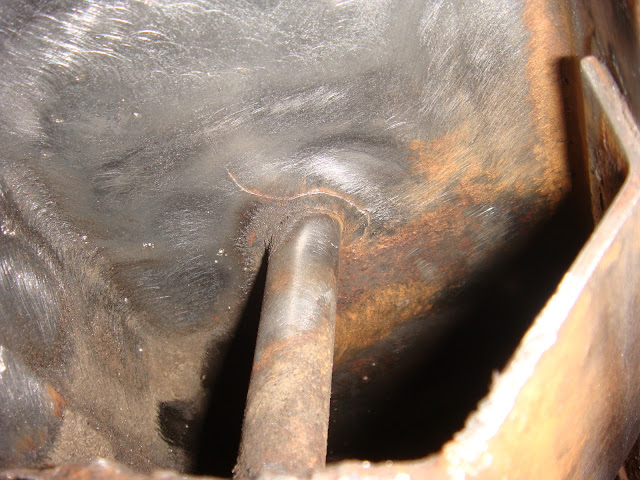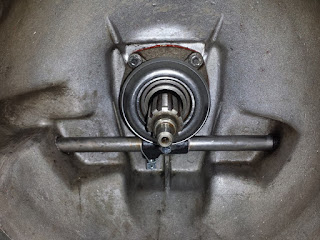At the Mitty this year, my transmission had a minor failure (felt major at the time). One of the 'idiot' switches in the top of the transmission finally wore out and jammed the shifter mechanism. While I was able to get my car up and running in a hotel parking lot and enjoy the trip, I decided that I needed to take some time this summer to open the trans back up when I got back home.
I want to address a few things that I figured were causing some leaks, as well as replace all the switches in the top as preventive maintenance (don't want that failure again on another switch!)
The list includes-
-Replace the rear seal on the OD - I did not replace this many years ago when I rebuilt the trans. Should have done it, but did not. It is leaking at least a little and is relatively easy to replace while its out. I made myself a locking bar to allow myself to pop the rear nut and actually broke that one. Will need to make a newer, much more substantial bar!
-Add a vent hole to the top cover - After learning about the vent hole several years ago, I suspected that mine did not have one. Found out for sure in the Atlanta Airport Laquinta Parking lot! This is a quick add.
-Replace the O-rings on the shifter mechanism - A little more to this job, but they appear to be leaking pretty profusely. Time to do it while its out. May also do the 'Brosky mod' if necessary. Have not checked them to see if they have the weep hole in them.
-Re-seal the top cover to the trans - I did the sealing job that it currently has while worn out in a parking lot at 11pm at night. Need to do a better job than that!
-Checked the Pilot bush in the flywheel after I popped the trans out tonite, and it needs to be replaced. I have a new one somewhere....
-I plan to mod my cross shaft and fork for a through-bolt - No reason to tempt fate after putting it back in.
One other interesting note- I actually had oil pushing out of 2 of the 3 switch bodies on the trans. Yuck!
I followed the Buckeye Triumphs tech article on rebuilding the top cover, so you could just as easily follow that and do the job. I did find a couple things that make the job a little easier IMO.
I started off with the trans completely drained, and removed the cover.
Next up, I found a self tapping sheet metal screw that would go in roughly a 1/8" hole and then drilled each of the 3 detent plugs with a drill that matched the screw.
I then screwed in the screw into each plug. Don't use a cheap screw here. I did 6 of these plugs in the last 2 weeks. 5 of them were easy pulls, one broke a screw off it was seated so securely.
Then, I deviated from the Buckeye how-to a bit. I used claw hammer to pull the plugs. They used a screw driver if I remember right. However, I found the claw hammer does not mark the casting and gives a lot better leverage for pulling the plug. A rag over the top of the plug prevents the spring and ball from ricocheting around the shop when removed.
Next up, it was time to pull the shifter rods.
I used a 5/16" 8 point socket on my 1/4" drive socket wrench to pull the locks from each of the 3 shift linkages
You then must remove the shifter rods in order - Reverse, 1/2, then 3/4. To do this, you have to have them all in the correct position to get around the detent balls in the housing which prevent more than one linkage from moving at a time. Takes just a little jiggling of the linkages fore/aft, but it works.
I then pulled all of the spacers and shift forks out. As I did, I degreased them and wrote their position in the gearbox so I would know exactly where they would go back.
I've also replaced both the front and rear main seals on the trans in the meantime. While I had the rear flange off, I found that the seal had worn a slight groove on the flange. Just enough to catch a fingernail on it. I elected to chuck it up on my lathe and turn it with some fine emery paper to remove the groove. I only took 2 thou off of it, but the groove is gone. When I re-mounted the seal and flange everything went together very nicely/smoothly. I think this will be a nice seal!
My friend Ken mentioned above that this will likely be a While You're In There kind of job, and no doubt it is. While pulling the clutch rod to get at the front main seal, I found that the dreaded pin was broken. I also found that my clutch is worn enough to warrant a replacement.
With everything disassembled, it was time to tap the three detent holes for thread in plugs. - Note, These plugs are not available anymore, so you'll basically have to make them from a 7/16"-20 threaded bolt. Cut it off and then cut a notch in the top for a flat head screwdriver.
When I threaded these holes, I was pretty careful about where the chips went, so I tilted the casing with its front nose down and protected the inside end with a towel. Lotsa cutting oil and taking time resulted in perfect threads in each of the three holes when done with the 7/16"-20 tap.
After completing the tapping, I brushed out the holes very carefully to get rid of any swarf from the tapping and got ready to reassemble.
I pressed the seals lightly into place and then put the plate in place over them. On the advice of Phil J, I added a light layer of sealant over the plate before I screwed it in place. You should also note that the plate is not flat - it is bent to provide a little pressure when installed to hold the seals in place.
Reassembly, as they say in the terrible manuals is basically the reverse of disassembly. My use of a sharpie marker to note each of the fork and spacers positions made quick work of getting them back in their homes. A little light oil on the shift rods helped them slide into place quickly as well.
I installed the rods in the order of 3/4, 1/2, Rev. and secured it to its shifter fork with the lock screw using the 5/16" 8 point socket.
You may also be able to make out in one of the above pictures the dreaded weep hole in the center shift rod. My Friend Phil J suggested pounding a lead fishing weight into it however, I did not have any around. What I did have handy was some brass rod that fit the hole in a very tight fit. I had degreased the rods earlier, so they were clean. I added a drop of Loctite to the hole and then hammered the brass rod (1/16" dia) into the hole. After cutting off the ends close to the rod and filing them closer, I held one end to my anvil and peened the other end. I finished by filing it all smooth with the rod. With the Loctite used and the force needed to get the brass in the hole, I don't believe it will come back out.
After installing each of the rods, I followed this with the installation of the detent ball or plug, spring and retainer plug(screw-in). I put each plug in to a flush position with the surface, then turned it one turn in further. This resulted in a really good shift tension and holds the car in gear well. This is definitely an improvement over the previous tension in my car. (This is the part I missed getting pictures of!)
Finally, I was able to reinstall the top cover back on the transmission and get it ready for installation in the car.
Before installation, I did modify my clutch fork for a through bolt. I left the pin, so now I have a 'belt and suspenders' arrangement there.
Final thing worth noting on this job is that I replaced a very old (but still with some life in it) Borg and Beck clutch in the car. I replaced it with the 'Magic Clutch Kit' from TRF. This includes the Sachs pressure plate, Powertune Disc and a Koyo T/O bearing (I used my existing steel sleeve that I had modified many years ago).
The Magic Clutch Kit takes much less leg pressure than the B&B clutch. I'm a cyclist and have the legs that go with that hobby, so the old clutch did not bother me a bit, but I was aware of the pressure it took compared to other TR6's I had driven. This new clutch however feels like a Miata or something. Comparatively very little pressure needed. Its a nice setup and works well.
So the job is done -
All new seals in the transmission all the way around
All new switches (OD and Reverse light)
All new detents in the shifter mechanism (click, click, click)
New clutch and T/O bearing along with modified clutch fork.
Rebuilt clutch slave cylinder
New trans mounts.




















































